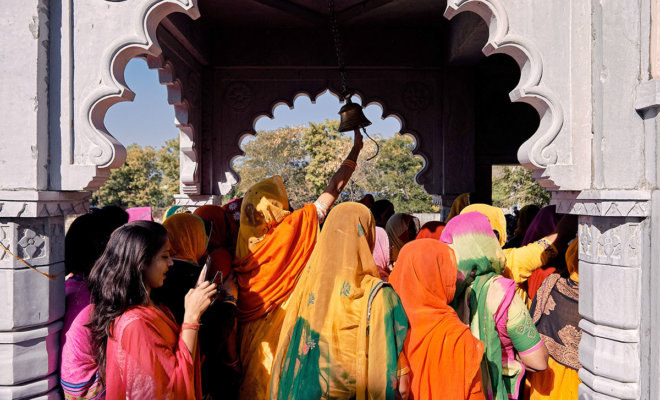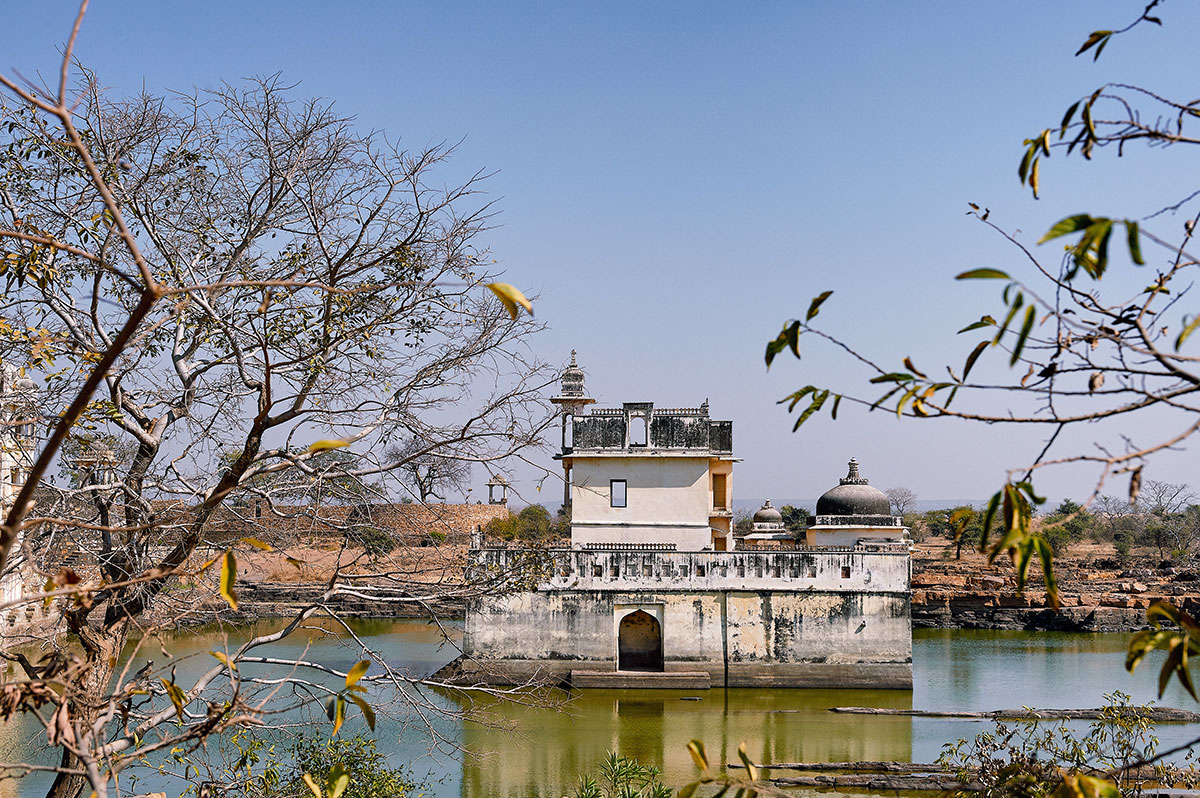Bollywood
Outraged Women in India Threaten Mass Suicide Over Bollywood Film

Women protest in Chittorgarh, India.
Photo: Poras Chaudhary/ The Washington Post
A leader of the demonstration at the fort claimed that more than 1,800 women were ready to set themselves on fire to protest the movie's release.
The queen’s palace is closed to visitors.
The white-domed building that sits – floats, really – on a reservoir inside a 7th-century fort here is named for Padmavati, the legendary queen who according to lore killed herself rather than be enslaved by a Muslim sultan.
Protests by a right-wing Hindu group over a new Bollywood movie about the queen forced the fort’s closure this week as violence spread across several states. Highways were blocked, shopping malls set ablaze and the film’s award-winning director, Sanjay Leela Bhansali, burned in effigy. Protesters pelted a school bus with stones, with the video of weeping children caught inside appearing on the evening news.
On Thursday the film, “Padmaavat,” debuted under heavy security, although many theaters were too scared to show it.
India has long banned books or films over sensitivities to certain castes or religions, but the prolonged disruption caused by this film has raised concern that India is growing more divided – and that its governing political party, with roots in Hindu nationalism, may be appeasing fringe groups as elections loom.
Since filming began last year, the movie has provoked the ire of members of the Rajput caste, descended from warriors, who claim the period drama damages the image of the Rajput queen, revered as a goddess and worshiped in a temple where an oil lamp flickers round the clock in her honor. A leader of this week’s demonstration at the fort claimed that more than 1,800 women were ready to set themselves on fire – as the queen did – to protest the movie’s release.
That did not come to pass. But in Chittorgarh, a subdued town of 180,000 nestled below the sprawling fort, Rajput women marched carrying fake swords and said they were prepared for die for their cause, just like Padmavati – or Rani Padmini, as she is known locally.
“They are showing our history incorrectly. They have not given a religious touch to it – they have given a glamorous touch to it,” said Manjushri Shaktawat, an organizer. “If they are showing such disrespect to Padmini, who sacrificed so much and died, how will they treat Rajput women in the future? The only weapon we have is to kill ourselves and finish it off.”

Padmini’s Palace in Chittorgarh, India. Photo: Poras Chaudhary/Washington Post
The trouble began last January, when protesters from an organization called the Shri Rajput Karni Sena descended upon the film’s set at a different fort and slapped Bhansali, pulled the director’s hair and damaged cameras. Production for the film – one of the most expensive Bollywood movies ever made – moved to another state. The crew was attacked there, too, with gasoline bombs and swords.
Protesters wrongly believed the film showed the queen – played by Deepika Padukone, Vin Diesel’s co-star in “XXX: Return of Xander Cage” – in a love scene with the Muslim conqueror. In fact, in the film the sultan only sees her face in a mirror, shrouded by incense smoke.
In November, protests again broke out, despite a video plea from Bhansali, who said that the film was a “tribute” to the queen’s sacrifice and that “there is nothing in the film which will hurt anyone’s sentiments.” A state-level spokesman for India’s governing Bharatiya Janata Party (BJP) inflamed tensions by offering $1.5 million for Padukone’s head. The film’s producers delayed its release.
Many historians doubt Padmavati existed. Accounts of the Chittorgarh fort’s siege in 1303 by Sultan Alauddin Khilji do not mention her, at least directly, according to Rima Hooja, author of “A History of Rajasthan,” although thousands of women did self-immolate, an act known in India as “jauhar,” as the fort was to fall.
The legend of Padmavati emerged in an epic poem penned more than 200 years later by a Sufi poet, who describes a queen whose beauty entranced Khilji and drove him to possess the fort.
“There is no direct evidence that such a person existed,” said Aditya Mukherjee, chair of the Center for Historical Studies at Jawaharlal Nehru University in New Delhi. “This has got nothing to do with history and everything to do with politics. It’s an attempt to mobilize support and votes on the basis of identity issues.”
He continued, “It’s not so much about Rajput pride as a Hindu-Muslim issue, where Muslims are the predators and Hindus have to protect themselves.”
BJP state spokesman Tuhin A. Sinha said the charge that politicians are encouraging such tensions and that BJP-led state governments are not doing enough to quell them is “absurd.”
Residents of Chittorgarh believe Padmavati is real, her history kept alive through generations of bards and by their own grandparents, who would weave tales of brave Rajput queens such as Padmavati – whose skin was so translucent you could see water running down her throat as she drank, according to the lore.
About 40 or so Rajput women marched to her temple Wednesday, trailed by female police officers, their watchful male family members and the media. The Rajputs are deeply conservative, and many of the women still observe the tradition known as purdah, which means they wear veils in public and cannot travel far alone. They chanted: “We are not flowers! We are sparks! We are the women of India! Shoot Bhansali!”
Aarti Kanwar Rathore, 25, who is a mother of a 2-year-old and has a master’s degree in political science, declared she was willing to commit suicide over the film’s “wrong history” – including the scene of the queen dancing in a revealing costume, which she said Rajput woman of that time would never do.
The protest concluded peacefully, and the women claimed a moral victory because the film would not be shown for miles around – as good as a formal ban, they said.
In the end, Bhansali made five modifications to the film to appease India’s powerful censor board, including adding disclaimers that the film was based on a fictional poem. A cover was digitally added to the triangle of flesh from Padukone’s midriff that could be seen in a dance scene. Despite a Supreme Court order, distributors and multiplex owners in four states are not showing the film, citing safety concerns.
Reviewers took note of Bhansali’s lavish sets and costumes and described an over-the-top performance by actor Ranveer Singh as the rapacious sultan. In the end, ordinary moviegoers might wonder what all the fuss is about, reviewer Sonal Kalra wrote in the Hindustan Times.
“There’s so much praise of Rajput courage and valour added in the film that most people are likely to have trouble finding anything remotely controversial,” she wrote, “even if they tried.”
© 2017, The Washington Post

You must be logged in to post a comment Login